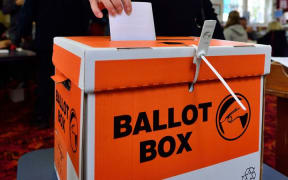
Stats NZ spent two years fixing the 2018 Census, only to discover it had undercounted Māori by up to 49,200 back in 2013. Photo: RNZ /Dom Thomas
An undercount of Māori by almost 50,000 in the census has raised questions if they should already have another seat in Parliament.
The census organiser Stats NZ is saying "maybe".
That is not good enough for Māori data experts, who say it is a fundamental question.
"To say 'maybe' for something that is constitutionally important, especially when the election's looking pretty tight, is not good enough," associate professor of statistics at Auckland University, Andrew Sporle said.
In analysis put out by Stats NZ earlier this year, the toll from two botched censuses for Māori - 2013 and 2018 - became clearer.
The agency spent two years fixing the 2018 census, only to discover it had undercounted Māori by up to 49,200 back in 2013. That's as much as a 7.6 percent undercount.
That raised the question "as to whether higher Māori descent census counts in 2013 would have enabled more Māori seats (for the 2014 and 2017 elections)", the analysis said.
"The answer to this question is inconclusive."
Sporle is unimpressed.
"This is fundamental, I mean, the census isn't just about counting people," he said.
"If we're short one seat, and one part of the population doesn't have that additional one seat to express their views, then that may actually compromise the quality of our democracy."
Stats NZ published its long and complex analysis of 2013 back in April this year, as it was preparing for next year's census, and not wanting any sort of repeat.
One of its senior demographers Kim Dunstan told RNZ they cannot be more definitive.
"The conclusion is, it is inconclusive," he said.
"That is the nature of some research, that you cannot have a definitive 'yes or no' answer."
The big 'maybe' is also not good enough for the Data Iwi Leaders Group.
It spent months with Stats NZ chewing over the 2013 and 2018 numbers, then put a statement:
"Data ILG and its mahi arm, Te Kāhui Raraunga, remain concerned that Stats NZ has not sufficiently addressed its concerns that errors by the agency may have costed Māori additional representation in Parliament.
"The problem is that Stats NZ simply does not know whether the undercounting of Māori in the 2013 census could have cost an extra Māori seat."
This, compounded by backfilling to fix major holes in the 2018 census, showed government was relying on Māori data practitioners, the group said in April.
"We need to move toward more hybrid approaches."
Why seven years?
Why did it take Stats seven years to discover the undercount?
"We didn't have any customers saying to us, 'Your estimate of the Māori population in 2013 was too low'," Dunstan said.
Reports released under the Official Information Act show the Electoral Commission met Stats NZ and told it the commission had no power to adjust the number of Māori seats and had to rely on the census counts.
The undercount "could also have impacted policy and other decisions - such as the allocation of funding between district health boards," Stats NZ said in one report.
"But unpicking the precise impacts is a significant undertaking and relies on a number of assumptions," it said.
It had done as well as it could at the time though "it can see that it did not deliver what was needed".
Its general manager of social and population insights Sean Broughton reiterated to RNZ it was not playing things down.
"In the context of Te Tiriti and constitutional arrangements, census counts are important, they're enormously important," Broughton said.
"But with 2013, that was the best available data at that point in time. There was no counterfactual."
Could it have done better, to improve the data?
"We'd be the first to admit that," Dunstan said.
"Yeah, we've moved on from 2013 to try and improve things for 2018. Some things didn't work well in 2018 either, although, you know, the end result did result in higher coverage from Māori."
Censuses always miss some people, and the counts are always gone over afterwards to make the population counts more accurate; however, it is only the initial census count that feeds through into any electoral changes.
Sporle said not just the undercount, but the timing of when the Māori count was made public, had also counted against them.
If Māori knew the count, and knew it was close to triggering another Māori seat, they were known to make strategic decisions about which voter roll - the Māori or general one - to go on. But in 2018 they did not know in time, he said.
The government is introducing law changes to the Māori electoral option.
Also, the largest review of the electoral system in 30 years is underway, and has already established Māori are being robbed of voting power - disenfranchised - and is looking into how that happens.
Meantime, Stats NZ is promising to do better at next March's census.
"Our focus is on making sure similar under-estimation does not arise in the future," it said in an OIA report.
It is doing it with millions of dollars more than in 2018, but still millions less than the agency told the government in 2020 it needed.
Sporle fears not putting in an extra $20m might come back to bite Māori, again.
The Data Iwi Leaders' Group is putting stock by its Mana Ōrite agreement with Stats NZ.
The undercount "brings into sharp focus the importance of quality data, and the disproportionate impact on Māori when it is not done correctly", it said.





